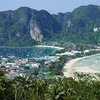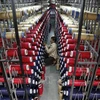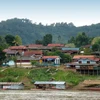Lao people nationwide are excitedly looking forward to a long holiday during their upcoming New Year festival (called Pi Mai), a time for family reunions, gatherings of friends, and big feasts.
This year’s New Year holiday will extend from April 14 to April 17, instead of the traditional April 14-16 period, as agreed by the Lao Government. The people will work on April 11 to make up for the one-day extension.
Lao people celebrate their New Year according to the ancient Hindu calendar, which falls around April 14, 15 or 16 in the Gregorian calendar. The celebration is considered to be the most important and biggest traditional festival in the country.
The festival, coinciding with the end of the dry season and the start of the monsoon season, features a rebirth and purification theme.
This year’s New Year holiday will extend from April 14 to April 17, instead of the traditional April 14-16 period, as agreed by the Lao Government. The people will work on April 11 to make up for the one-day extension.
Lao people celebrate their New Year according to the ancient Hindu calendar, which falls around April 14, 15 or 16 in the Gregorian calendar. The celebration is considered to be the most important and biggest traditional festival in the country.
The festival, coinciding with the end of the dry season and the start of the monsoon season, features a rebirth and purification theme.
According to Lao legend, Pi Mai celebration started after Phaya (King) Kabinlaphom lost his life in a bet to a man named Thammabane Khumman after he was unable to solve a three-part riddle. Per his request, his seven daughters (representing each day of the week) took great care not to let his severed head touch the ground, lest there would be great destruction throughout the world.
Kabinlaphom’s head was kept at the Kantoumalycave until Pi Mai when each of his daughters took turns cleansing it.
Today, this story is re-enacted during the country’s New Year celebrations. The community chooses a female to represent Nang Sangkhane, one of the seven daughters, to lead a procession or parade showcasing a replica of Phaya Kabinlaphom on a ceremonial tray called Khan.
For 2015, Nang Sang Khane (or Miss Lao New Year) will be selected as Kabinlaphom’s third daughter, known as Harksa. Her dress (mola) is made from silk with a lotus design. Blood will be her food and she will carry a three-point sword (conveying the message that everyone needs to be careful on the road). She will also ride a pig with arrow in her left hand.
Every year, the practice is changed, varying in the king’s daughters, her dress, food, symbolic weapon, and the animal she rides.
Pi Mai is a three ‐ day event. The first day, April 14, is called Sangkhane Luang, or the last day of the old year. On the day, people clean their houses in preparation for the New Year. They earn merit and blessings by building mounds of sand, usually on the river banks and temple grounds, which are then decorated with small triangular flags, flowers, money and candles.
The second day, on April 15, is called Sangkhane Nao, the day between the old and the New Year; it is considered neither part of the old year nor the New Year. Sangkhane Nao is also known as the day of rest and all work is forbidden. Only festive activities are to take place, such as visiting relatives and friends, taking a day trip or the customary throwing of water on friends and passersby.
At night, there is usually a Lamvong (Lao traditional dance) or circle dancing party. Everyone dresses their best to partake in the celebration with plenty of available food and drinks.
The third day of the Lao New Year festival is called Sangkhane Kheun Pi Mai. It is the start of the New Year and the most joyous day of the festival. People traditionally go to the temple and make offerings to earn merit.
Young people prepare scented water with flowers and visit their grandparents, parents, and elders. They rinse the elders’ hands with the water and ask for their blessings and forgiveness for any wrong ‐ doings in the past year.
The second day, on April 15, is called Sangkhane Nao, the day between the old and the New Year; it is considered neither part of the old year nor the New Year. Sangkhane Nao is also known as the day of rest and all work is forbidden. Only festive activities are to take place, such as visiting relatives and friends, taking a day trip or the customary throwing of water on friends and passersby.
At night, there is usually a Lamvong (Lao traditional dance) or circle dancing party. Everyone dresses their best to partake in the celebration with plenty of available food and drinks.
The third day of the Lao New Year festival is called Sangkhane Kheun Pi Mai. It is the start of the New Year and the most joyous day of the festival. People traditionally go to the temple and make offerings to earn merit.
Young people prepare scented water with flowers and visit their grandparents, parents, and elders. They rinse the elders’ hands with the water and ask for their blessings and forgiveness for any wrong ‐ doings in the past year.
At home, they engage in a special family ceremony called the Sukhwan (Baci ceremony) to welcome the New Year. Participants take turns tying the blessed white strings around each other’s wrists to wish them good luck and prosperity for the New Year.-VNA/KPL



















